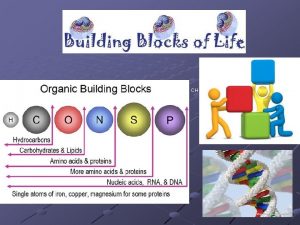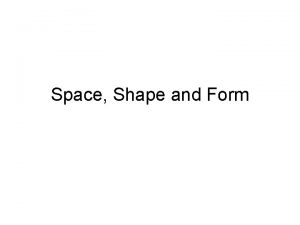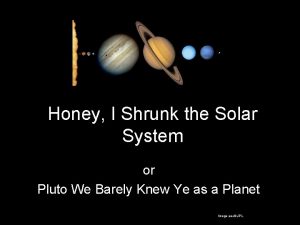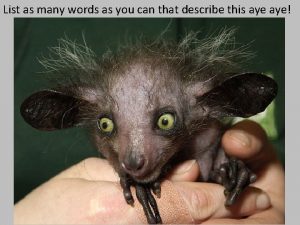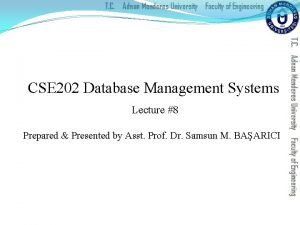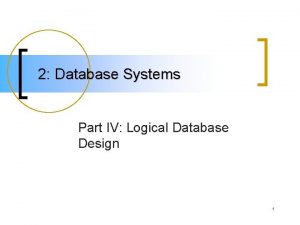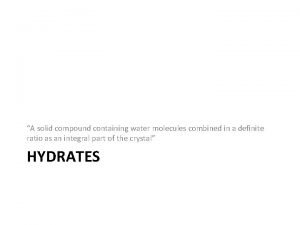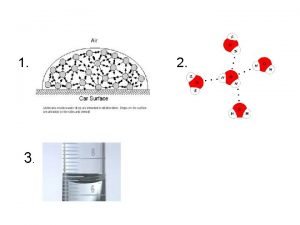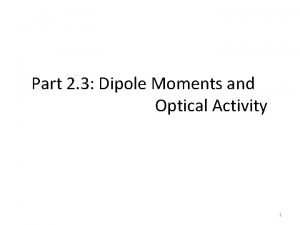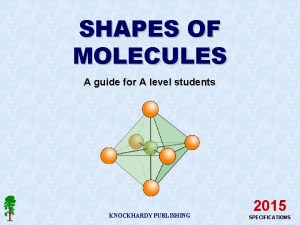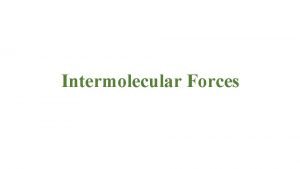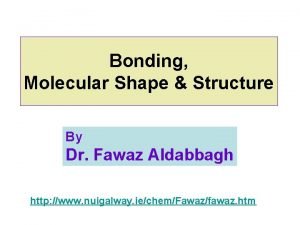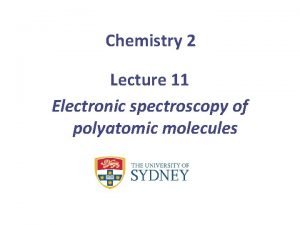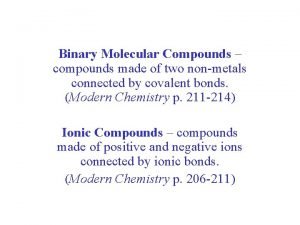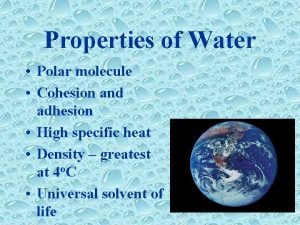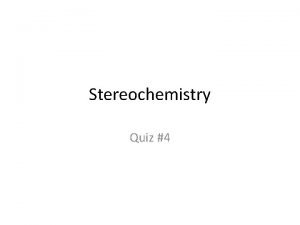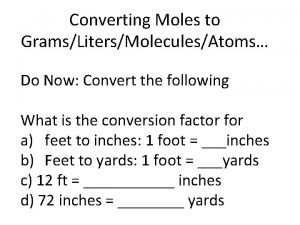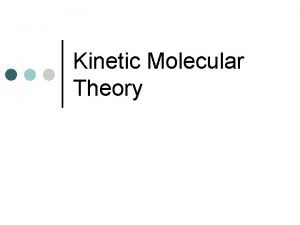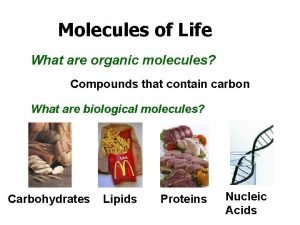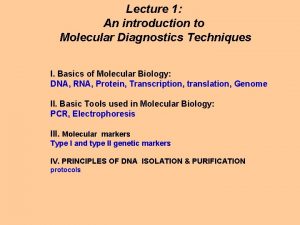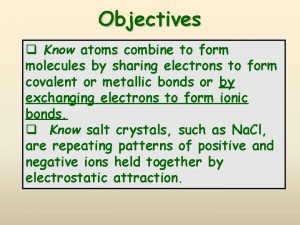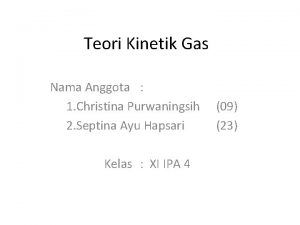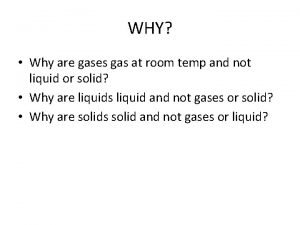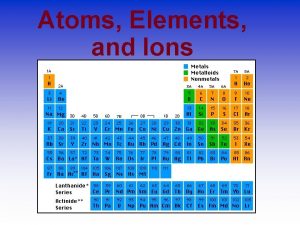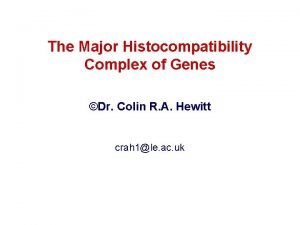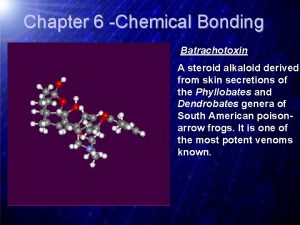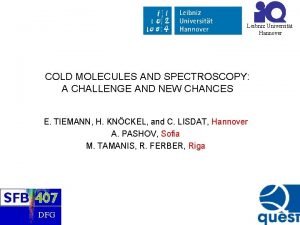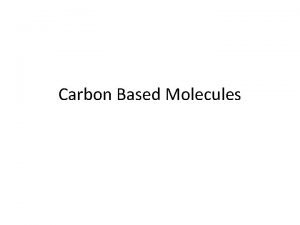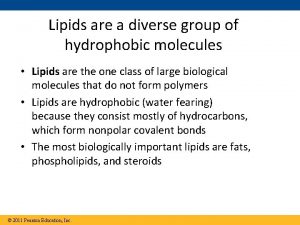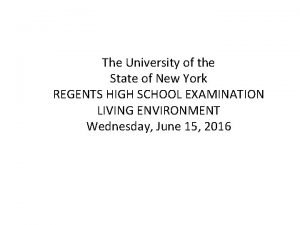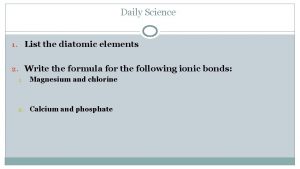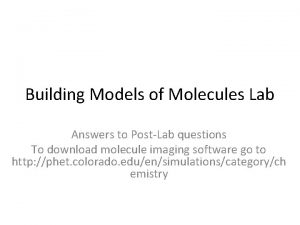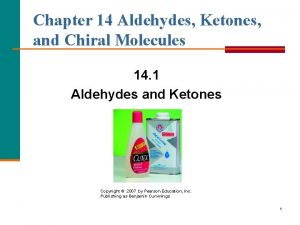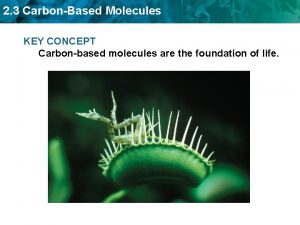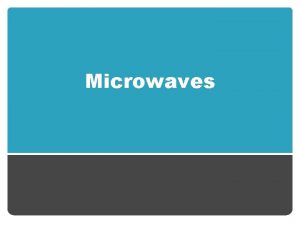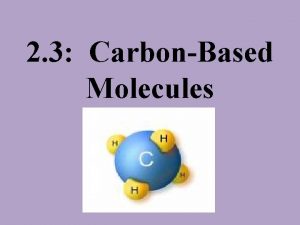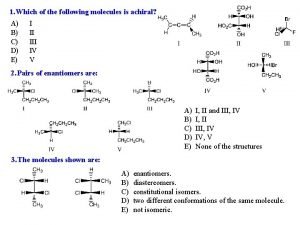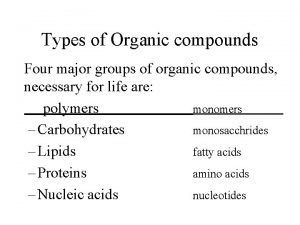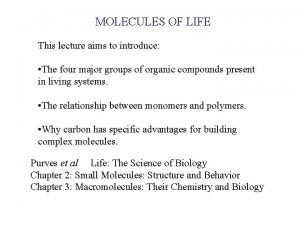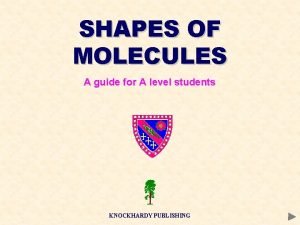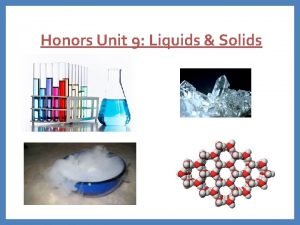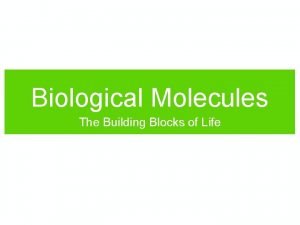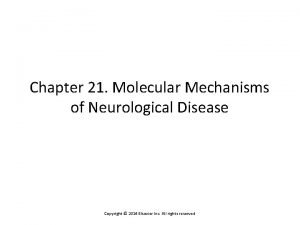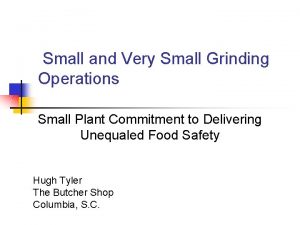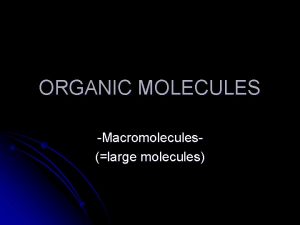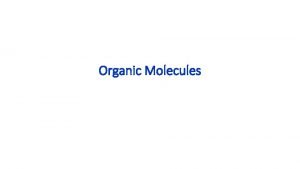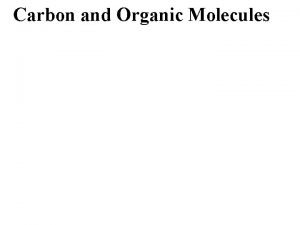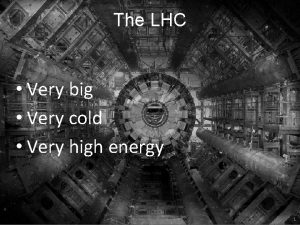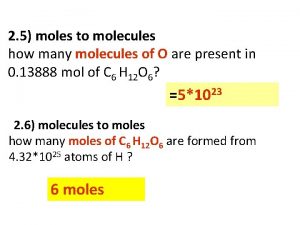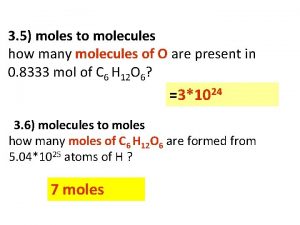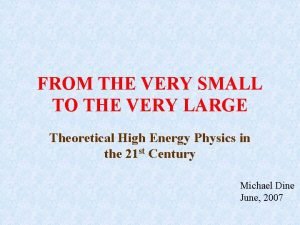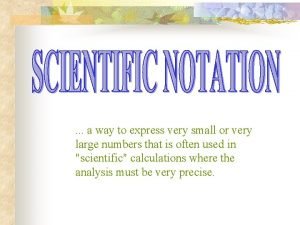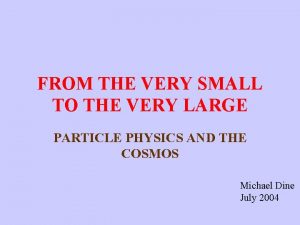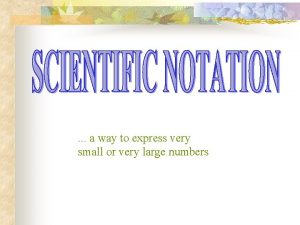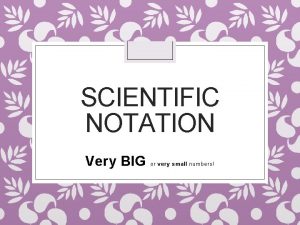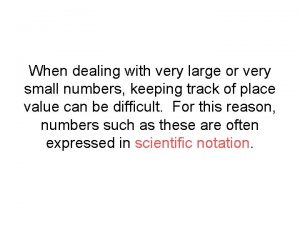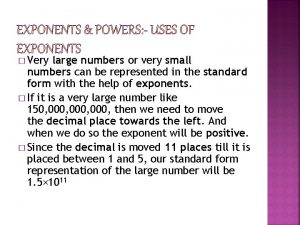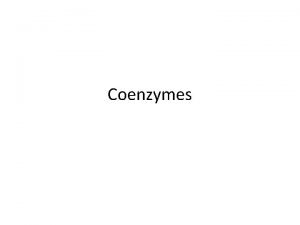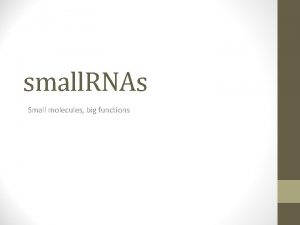CH 3 Many molecules are very small micromolecules









































































- Slides: 73

CH 3

Many molecules are very small (micromolecules) Others are very large (macromolecules) 4 types---organic molecules n n Carbohydrates Lipids Proteins Nucleic acids

Organic compounds are structural (building) or informational (heredity) Many are polymers (repeating units) n n Monosaccharides complex carbs Amino acids protein/polypeptides Nucleotides nucleic acids (DNA, RNA) Fatty acids/glycerol lipids (not polymers)


Cellular Structure Polymer Monomer


Subunits Function Examples

Subunits Function Examples

Building Macromolecules Subunits joined by covalent bonds n n -OH removed from one subunit -H removed from other subunit DEHYDRATION SYNTHESIS (aka Condensation)one molecule of water is removed as subunits are linked --anabolic (build up) --requires input of energy --stressing and breaking of bonds is carried out by enzymes---catalysis

Dehydration Synthesis

HYDROLYSIS- (hydro – add water, lysis – to split) - molecule can be broken down into subunits as water is added n n Catabolic Energy released

Hydrolysis

Dehydration synthesis vs Hydrolysis

Crash Course Biological Molecules

CARBOHYDRATES (sugars/starches) Contain C, H, O in 1: 2: 1 ratio Function in energy storage, support Important monosaccharides have 6 carbons---major one is glucose n These are straight chains but dissolve and form rings in water

Glucose, fructose and galactose all have the same molecular formula-- C 6 H 12 O 6 these are called ISOMERS n n Atoms are arranged differently Glucose and fructose are structural isomers =o is attached to different carbons n Glucose and galactose are stereoisomers Different in orientation of –OH groups (mirror images) mirror images

Again…ISOMERS Molecules that have same molecular formula but different structure… n Ex. glucose, fructose, galactose

DISACCHARIDES n n n “double sugars” 2 monosaccharides joined by a covalent bond Can play a role in transport of sugars…transport disaccharides Transport disacch. Protects sugar from being metabolized during transport…. less readily used for energy when in this form Some organisms(specifically plants), glucose is converted to a transport form before being circulated glucose + glucose = maltose glucose + fructose = sucrose (table sugar) glucose + galacatose = lactose (milk sugar)

Formation of disaccharides

POLYSACCHARIDES n n Starches—insoluble in water Consists of glucose molecules linked in chains Energy storage, structural support Amylose, pectins, cellulose, glycogen,

Amylose - simplest starch, hundreds of glucose linked in unbranched chains. Potato Starch 20% amylose Pectins - branched chains with short linear amylose branches n Amylopectin is the part of a starch that prevents it from being solulable Glycogen - animal storage product, stored in liver


Cellulosen Orientation of glucose subunits(CH OH) 2 are on alternate sides so difficult for enzymes to break bonds dietary fiber, component of plant cell wall

Cellulose

cellulose

Starch vs. cellulose



The carbohydrates produced or consumed by an organism are used in 3 ways… n n n 1. maintained as glucose/immediate energy 2. converted to transport disaccharides 3. converted to starch, glycogen or fat(adipose) reserved for future use

LIPIDS fats, oils, waxes Contain C, H, O >2: 1 ratio of H: O Insoluble in water— n Many lipid molecules cluster together when put in water and expose their hydrophilic (polar) groups while protecting their hydrophobic (non-polar) groups (important in cell membrane) Phospholipids, fats, oils, terpenes, steroids, prostaglandins are types of lipids

Types of Lipids PHOSPHOLIPIDS form cell membranes n Composite molecule made up from glycerol, 2 -fatty acids, and a phosphate group Glycerol—a 3 -carbon alcohol…. . forms the backbone of the molecule 2 Fatty acids– long hydrocarbon chains ending in a carboxyl group (---COOH). Phosphate group– attached to one end of the glycerol Has a polar “head” (hydrophilic) at one end and 2 very long nonpolar “tails” (hydrophobic) at the other Form 2 layers with tails pointing at each other

phospholipid

Phospholipid bilayer

FATS n n n n n A glycerol attached to 3 fatty acids Called a triglyceride Store energy for long periods in the many C-H bonds Because they are insoluble in water, they can be deposited at specific locations within organisms Animal fats, oils, earwax, beeswax If all internal carbons have single bonds between them in the fatty acid chains—saturated If the fatty acids have double /triple bond between them—unsaturated More than 1 double/triple bond—polyunsaturated Form micelles (droplets) in water

Fat Structure

Fats made from polyunsaturated fatty acids have a low melting point ---fatty acid chains bend at the double bonds, preventing the fatty acids from aligning Poly. Fat(corn oil) is usually liquid at room temp and is called an oil. PLANT FATS Most saturated fats(butter) are solid at room temp ANIMAL FATS Possible to convert oil solid by adding hydrogen (hydrogenated) However, artificially hydrogenating unsaturated fats eliminates the health advantage

. nn

Types of lipids (cont) Terpenes-long chain lipids that are components of many biological pigments(chlorophyll, retinal). Rubber is also a terpene Steroids-composed of 4 carbon rings. Cholesterol (in cell membrane), testosterone and estrogen (hormones) Prostaglandins-a group of 20 lipids that are modified fatty acids…act as local chemical messengers (neural modulators) in vertebrates n Aspirin inhibits prostaglandin synthesis so reduces pain/inflammation…

Cholesterol ( a steroid)

Fats are a more efficient energy storage molecule than carbs n n n Most fats contain over 40 carbon atoms; ratio of C-H bonds to carbon atoms is twice that of carbs Fats yield 9 kcal of energy per gram Carbs yield 4 kcal of energy per gram

PROTEINS Contain C, H, O, N (occasionally sulfur) Polymers of amino acids Specific order of aa determines the protein’s structure AND function Diverse functions n n n Globular—enzymes, antibodies, transport proteins (hemoglobin, myoglobin, transferrin-iron) Fibrous—structural/support ( ex. keratin, actin+myosin, collagen) Peptides– hormones, intercellular messengers p. 40

Structural protein

Antibody protein

20 different amino acids arranged in various sequences. Scientists believe these to be among the first molecules formed Amino acid is formed from amine group (NH 2) and a carboxyl group (-COOH)

The identity of an amino acid is determined by the R-group or variable group (which is covalently bonded to the central carbon atom) The variable group determines it’s solubility

5 Classes of Amino Acids (based on the R group ) Nonpolar - R groups contain CH 2 or CH 3, Polar (uncharged)-R groups contain only H or OH, ex. Threonine Ionizable - R groups contain acids/bases, ex. glutamic acid Aromatic - R groups contain an organic ring with alternating single + double bonds. Nonpolar, ex. phenylalanine Special function - have specific properties n n n Methionine - initiates protein synthesis Proline - caused kinks in chain Cysteine - links chains together pg. 45

Amino Acid Chart

Amino Acid Chart continued

Amino acids are joined by dehydration synthesis and linked by peptide bonds 2 amino acids joined creates a molecule called a dipeptide


Protein Structure Shape of protein determines it’s function X-ray diffraction used to determine structure(3 -D) (myoglobin was first protein analyzed this way…then hemoglobin) 4 Levels of protein structure n n Primary-sequence of amino acids in chain Secondary-hydrogen bonding within the primary chain Alpha-helix Beta-sheet folds/creases called motifs

n Tertiary-final folded shape of a protein Spontaneous. . driven by hydrophobic interactions w/water A mutation that changes a single amino acid within protein’s interior can disrupt the protein’s stability and have major structural consequences n Replacing a polar a. a with a nonpolar one can cause a “sticky patch” on surface of protein…hence sickle-cell anemia (nonpolar valine replaces polar glutamate) Domains- sections of this structure with diff. functions (cofactor, active site…within 1 protein)

Quaternary-clustering of more than 1 polypeptide chain (each has it’s own tertiary structure). Each is called a subunit

Sickle cell

Sickle cell mutation

Levels of Protein Structure


If the nonpolar sticky interior of protein chains are exposed during their arranging, they can stick to other unwanted protein partners Chaperone proteins—help new proteins fold correctly. (scientists unsure how they work) ********************

If a protein’s environment is altered, it may change its shape - denaturation Denaturation = inactive due to changes in p. H, temp, conc. Enzymes function in a narrow environmental range Protein shape changes but bonds do not!! Renaturation – the ability of a small protein to spontaneously refold into it’s original shape when the normal environment is reestablished - this suggests that the tertiary structure is strongly influenced by primary structure


NUCLEIC ACIDS Store and transfer genetic information DNA encodes info RNA reads info and directs protein syn. Polymers of nucleotides linked by phosphodiester bonds n n A pentose (5 -C sugar), a phosphate group, a nitrogenous base Phosphodiester bond – bonds between the phosphate of one nucleotide and the sugar of the next nucleotide

nucleotide

Polynucleotides (chains of nucleotides) have different ends: a phosphate on one end an --OH from a sugar on the other end. These ends are referred to as 5’ (“Five Prime, ”--PO 4) and 3’ (“three-prime, ” –OH), which are taken from the carbon numbering of the sugar


Types of Nitrogenous Bases Purines – large, double-ring molecules Adenine (A) and Guanine (G) Pyrimidines – smaller, single-ring molecules. Cytosine (C), Thymine (T), and Uracil (U)


DNA-RNA connection

DNA vs. RNA DNA RNA Double-stranded helix Single-stranded Sugar is deoxyribose Sugar is ribose Adenine, thymine, cytosine, guanine Adenine, uracil, cytosine, guanine

Summary Chart Compound Elements Carbs C, H, O polymers 2: 1 Lipids C, H, O not polymers > 2: 1 Units fatty acids, glycerol, some phosphates fats, oils, waxes, terpenes, steroids……… Protein Amino acids enzymes, most hormones, hemoglobin… polymers C, H, O, N (S) mono, di, poly, saccharides Examples sugars, starches Nucleic C, H, O, N, nucleotides DNA, RNA acids polymers P


3 other nucleotide containing molecules 1. Nicotinamide Adenine Dinucleotide (NAD+) 2. Flavin Adenine Dinucleotide (FAD) These 2 molecules are used as electron carriers in different cellular processes, which will be discussed in future units

3. ATP the energy currency of the cell Adenosine triphosphate High energy molecule produced as a result of respiration Contains the nucleotide base: adenine

http: //www. bozemanscience. com/042 biologoical-molecules
 Antigentest åre
Antigentest åre Micromolecules
Micromolecules Examples of micromolecules
Examples of micromolecules Micromolecules and macromolecules
Micromolecules and macromolecules Multiplication of scientific notation
Multiplication of scientific notation Organic molecules vs inorganic molecules
Organic molecules vs inorganic molecules Quantifiers with food
Quantifiers with food Very bad to very good scale
Very bad to very good scale There is very few soup in the bowl
There is very few soup in the bowl Is a very shallow skillet with very short sloping sides
Is a very shallow skillet with very short sloping sides What is an atom made up of
What is an atom made up of Form shape and space
Form shape and space Eris dwarf planet
Eris dwarf planet List as many words
List as many words Many sellers and many buyers
Many sellers and many buyers What is unary relationship in dbms
What is unary relationship in dbms Many to many communication
Many to many communication Unary many to many
Unary many to many Sqlbi many to many
Sqlbi many to many Er diagram in dbms
Er diagram in dbms Many sellers and many buyers
Many sellers and many buyers Contoh erd many to many
Contoh erd many to many Unary relationship database
Unary relationship database Unary many to many
Unary many to many Unary many to many
Unary many to many A solid compound that contains water molecules
A solid compound that contains water molecules Non polar molecules that include fats oils and cholesterol
Non polar molecules that include fats oils and cholesterol Homework
Homework Symmetry molecules
Symmetry molecules Shapes of molecules a level
Shapes of molecules a level Covalent molecules
Covalent molecules Examples of non linear molecules
Examples of non linear molecules Electronic spectra of polyatomic molecules
Electronic spectra of polyatomic molecules Binary molecular (covalent) compounds are made of two
Binary molecular (covalent) compounds are made of two Adhesion and cohesion in dentistry
Adhesion and cohesion in dentistry Bond angle tetrahedral
Bond angle tetrahedral Indicate the relationship of the pair of molecules shown.
Indicate the relationship of the pair of molecules shown. Liters to grams stoichiometry
Liters to grams stoichiometry Liquid molecules
Liquid molecules Atoms ions and molecules
Atoms ions and molecules Substance
Substance Bead like structures formed by dna and histone molecules
Bead like structures formed by dna and histone molecules Polysaccharides
Polysaccharides Molecules biology definition
Molecules biology definition Molecular shapes polar or nonpolar
Molecular shapes polar or nonpolar Atoms molecules and ions
Atoms molecules and ions Why do atoms combine to form molecules
Why do atoms combine to form molecules Gas bermassa 4 kg bersuhu 27
Gas bermassa 4 kg bersuhu 27 Solid to gas
Solid to gas Interacting molecules or ions
Interacting molecules or ions Which elements exist as diatomic molecules
Which elements exist as diatomic molecules Mhc molecules
Mhc molecules Phosphorus hexachloride lewis structure
Phosphorus hexachloride lewis structure Cold molecules
Cold molecules Carbon based molecules
Carbon based molecules It is diverse group of hydrophobic molecules
It is diverse group of hydrophobic molecules Farmers may someday clone their best milk producing
Farmers may someday clone their best milk producing Diatomic elements
Diatomic elements Building molecules lab answers
Building molecules lab answers Test for alkanal
Test for alkanal The attractive force between water molecules
The attractive force between water molecules Carbonbased molecules in
Carbonbased molecules in What molecules are microwaves are most attracted to
What molecules are microwaves are most attracted to Converting from molecules to moles
Converting from molecules to moles Protein monomer
Protein monomer Which of the following molecules are achiral?
Which of the following molecules are achiral? Collision theory states that
Collision theory states that The four types of organic compounds
The four types of organic compounds Identifying molecules
Identifying molecules A level chemistry shapes of molecules
A level chemistry shapes of molecules Illustration of molecules
Illustration of molecules Biological molecules what are the building blocks of life
Biological molecules what are the building blocks of life From molecules to networks
From molecules to networks What is the relationship between atoms and elements
What is the relationship between atoms and elements


